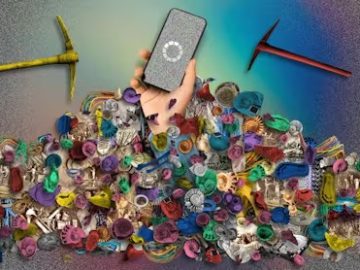The stuff of Salvador Dali’s wildest dreams is no match for Facebook these days: Amputee kittens using crutches. Strawberries in the shape of lifelike frogs. Bosomy conjoined twins, structurally impossible sand sculptures, snakes swallowing fully-grown lions, airplanes with human hands. An underwater Jesus covered in shrimp.
These unsettling images appear in our social media feeds, sometimes as a jump scare, and sometimes as a Trojan horse. They might be accompanied by a manipulative caption — “99% of people will scroll past without clicking like” — or hashtag gobbledygook that often includes, for some reason, a combination of the words “Scarlett Johansson beautiful cabin crew.” The replies, a medley of gullible users and likely bots, are usually full of compliments for the insane image.
Khan Schoolcraft, 33, moderates a Facebook group called “AI Boomertrap,” which collects examples of the genre (the cheeky name refers to the demographic that seems to get duped into thinking the images are real — though anyone can fall for it). Schoolcraft has seen it all. “Tiger Jesus saving his beautiful cabin crew from a plane that’s slowly sinking in the mud,” he says, by way of example. “You’ll see, like, a half-human, half-baby monkey hybrid getting eaten alive by fire ants, and people are commenting, ‘Oh so beautiful, I love it. Amen. God bless.’”
Even the more prosaic images have a certain aesthetic — like the trend of AI-generated human quadruplets or centenarians asking for birthday wishes with their supposedly handmade cakes, whose designs defy the contours of reality. People somehow don’t see, or look past, the obvious signs of software-generated fakery and surreality.
The craziness of the content is balanced by “this incredibly banal, realistic style” that’s “very easy to process,” says Jonathan Gilmore, a professor of philosophy at the City University of New York, and co-editor of the Journal of Aesthetics and Art Criticism.
These pictures are “slop,” the tech world’s term for the image equivalent of spam. But they’re also a new category of surrealism. From a certain perspective — if your interpretation is broad enough — they may even be art. Not good art, by any definition, but they raise interesting philosophical questions about how we think about and classify images generated by AI.
Maybe these images — designed to attract attention to scam pages or click-baity sites full of ads — are a sign of the rise of the “zombie internet,” populated by AI and bots. But that’s not what we’re going to talk about.
We’re going to talk about why they look the way they do: flat, mawkish, uncanny. There’s a good reason one of the AI image generation programs is named DALL-E (a fusion of Dali and the title character of the Pixar movie “WALL-E”). Everything feels surreal these days. Can these surreal images somehow bring us to a clear truth?
The French writer André Breton wrote, in his 1924 “Manifesto of Surrealism,” that the genre elevates the “superior reality” of the subconscious mind — that dreams and reality can combine to create a reality that is somehow more real. But what happens when the entity creating a surreal image isn’t human? What if the creator itself is surreal?
“These are serious questions in philosophy of art right now,” says Gilmore. The questions “cut to the core of our concept of art, and what we mean by art, and what we think art should do for us.”
Art should make us feel something. On that metric, Facebook slop actually succeeds, but in the most obvious, lowbrow way. Because the images are designed to get people to interact with certain Facebook pages, they tug at the heartstrings with subject matter that’s sympathetic or titillating: puppies, babies, patriotism, religion, elderly people, attractive people. This is the well-trod territory of cringe and kitsch.
“Because it is so kitschy, it’s essentially conservative, which might sound counterintuitive because it’s so bizarre and uncanny,” says Gilmore. Each image is its own melodrama, manipulating the viewer’s emotions.
He means conservative with a lowercase “c,” though the AI slop is usually politically conservative, too: Schoolcraft’s Facebook group is full of examples of troop-saluting, anti-LGBTQ+, pro-Trump schlock. A recent example: an elderly man in an American flag shirt and MAGA-esque red hat, reading the Bible to a dozen attentive drag queens. At a quick glance, the image might seem like a photo-illustration — but the letters on his hat are garbled, and he only has three fingers on each hand.
Robert Hopkins, a professor of philosophy at New York University who studies aesthetics, offers some other questions to evaluate whether an AI-generated work is Art with a capital A.
“Does it have real expressive power?” asks Hopkins, “Does it articulate feelings and moods and thoughts, and make them clear to you in a way that is distinctly artistic? … Is it interacting interestingly with preceding art?”
Humans do make AI art, in one sense: They must string together a description, or prompt, to tell the AI what image to make. In this sense, AI is a tool, like a sort of magic, automated paintbrush.
Art history is full of suspicious reactions to new technology. “Machines have come, art has fled,” said the painter Paul Gauguin, of photography. In its early days, critics thought artists could “never create great art out of photography, because all the photographer had to do was to set up the camera and … hit the shutter,” says Gilmore. “That was obviously untrue.”
Using any artistic tool requires skill. What separates “real” AI art and social media slop is refinery and context.
Polina Kostanda, a 45-year-old Ukraine-based AI artist who posts her work as Polly in Wonderland, also makes surreal, uncanny and dreamy images: grandmothers with mermaid tails, frogs smoking cigarettes, pepperoni pizzas growing like wildflowers. These descriptions might fit with the weird crap reposted on “AI Boomertrap,” except Kostanda sells prints and NFTs of her work, and is represented by a photo agency in Milan. Her objective is for viewers of her work to confront the boundaries of reality and “inspire them to go beyond their usual perceptions,” she says via email.
Kostanda’s work — for which she uses AI image-generating software called Midjourney — is free of the flat affect that plagues much of the social media art you see on Facebook, because she knows how to create a skilled prompt that evokes real photographic quality. In addition to prescribing the subject matter, she will also specify a film and camera as part of the prompt. “For example, Kodak Portra 800,” Kostanda says. “And the camera this photo was ‘taken’ with, for example: Hasselblad 503CW.”
What pushes an AI-generated image into the realm of art, she says, is whether it conveys a message, and whether it “catches the soul.”
“There are a lot of ‘dead’ physical paintings and photographs, without an idea or message,” says Kostanda. “And there are ‘live’ AI images” — images imbued with rich depth and meaning — “that can confidently be called art.”
If some images are live, and some are dead, here’s the Schrödinger’s Cat of AI: This month photographer Miles Astray won — and then was disqualified from — an AI photography contest. He submitted a real photograph of a flamingo whose head is tucked so far into its wing that it appears to just be a ball of feathers with legs — like a comically askew AI misinterpretation of what a bird is. On his website, Astray said he entered his photograph “to prove that human-made content has not lost its relevance, that Mother Nature and her human interpreters can still beat the machine, and that creativity and emotion are more than just a string of digits.”
The flip side could also become true: These schlocky, kitschy Facebook images could, in the proper context, become Real Art. Think of them as the digital equivalent to Readymades, artist Marcel Duchamp’s word for works he made with commercially manufactured objects like bicycle wheels or urinals. A savvy artist could emulate or exploit the style of these images to create a commentary on social media, consumerism, patriotism or religion. (Or — like the members of AI Boomertrap — for memes.)
Could AI Facebook slop even be beautiful? Vadim Meyl thinks so. Meyl, a researcher with the Central European University, published a paper in February asserting that “artificial intelligence stands as a defining beauty of our era.” The beauty of the system itself — not just its outputs but also its code and its algorithms that enable machine learning — “is of a new kind, one that may only be wholly grasped in future centuries,” Meyl writes in his paper.
Facebook slop, Meyl writes in an email, is more a problem of intent than aesthetics.
Dreamy, strange, thought provoking surrealism “which once seemed exclusive to the geniuses of their generation is now accessible through AI,” he says. But if those qualities become more associated with anonymous scammers on phishing pages than artistic geniuses in galleries, it may give us surrealism fatigue. Writes Meyl: “We will expect [the] ‘unexpected’ and lose [the] wow-effect of AI art.”
As an artistic tool, AI is still in its infancy. We’re still not sure how to appraise it, says Hopkins. Will it be judged along with the various forms of handmade art it emulates, or will it be in a category of its own?
One argument for the latter is that we judge works of art not only by how we experience them, but also by our understanding of how they were made.
“We value works of art sometimes when they are the product of great struggle, or a virtuoso ability,” says Gilmore. The perception of AI art is that it’s “undermined by the fact that it was just too easy to produce.”
Meyl believes that art created by human-made algorithms should be judged no differently than art created by human hands. He sees AI as a tool, like a pottery wheel. “It operates within the parameters set by the human creator,” he says.
So AI slop is art, in Meyl’s eyes. It’s just really amateurish, really corny, really bad art — kind of like most amateur art that humans have created across media throughout history.
Set aside the AI generator’s tendency to add or subtract fingers, and its ability to deceive. The question, then, is: Why are so many AI creators — from scammers to professional artists — stuck on this flat, kitschy, sometimes hackneyed form of surrealism?
“With this absolutely massive, seemingly infinite capacity to create a visual image, the work ends up looking so conventional,” says Gilmore. Unsettling and uncanny, yes, but somehow “so boring, so familiar.”
For example: several recent posts from a Facebook page simply called “Fascination,” which appears to be run from Armenia. The posts depict the same subject — a little boy who has purportedly painted, with skills beyond his years, a beach landscape — with the same caption: “My new artwork, please appreciate it.” The children look real enough, but the details of the images are giveaways. One of the lighthouses protrudes off the canvas; the ground shown under the easel is also rendered in brushstroke.
The image isn’t real. The boy isn’t real. The fake boy’s painting isn’t real. The posts are the modern rendition of the famous Rene Magritte work “La Condition Humaine,” a painting of a painting that blends into its background so seamlessly that you can’t tell what part of the scene is real.
“You are so talented,” a commenter named Daphne (is she real?) replied to one of the posts. “That’s what I call a work of art.”




